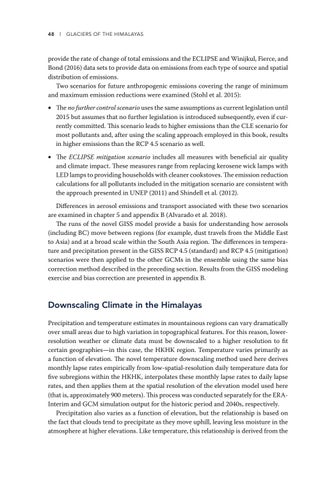48 l Glaciers of the Himalayas
provide the rate of change of total emissions and the ECLIPSE and Winijkul, Fierce, and Bond (2016) data sets to provide data on emissions from each type of source and spatial distribution of emissions. Two scenarios for future anthropogenic emissions covering the range of minimum and maximum emission reductions were examined (Stohl et al. 2015): · The no further control scenario uses the same assumptions as current legislation until 2015 but assumes that no further legislation is introduced subsequently, even if currently committed. This scenario leads to higher emissions than the CLE scenario for most pollutants and, after using the scaling approach employed in this book, results in higher emissions than the RCP 4.5 scenario as well. · The ECLIPSE mitigation scenario includes all measures with beneficial air quality and climate impact. These measures range from replacing kerosene wick lamps with LED lamps to providing households with cleaner cookstoves. The emission reduction calculations for all pollutants included in the mitigation scenario are consistent with the approach presented in UNEP (2011) and Shindell et al. (2012). Differences in aerosol emissions and transport associated with these two scenarios are examined in chapter 5 and appendix B (Alvarado et al. 2018). The runs of the novel GISS model provide a basis for understanding how aerosols (including BC) move between regions (for example, dust travels from the Middle East to Asia) and at a broad scale within the South Asia region. The differences in temperature and precipitation present in the GISS RCP 4.5 (standard) and RCP 4.5 (mitigation) scenarios were then applied to the other GCMs in the ensemble using the same bias correction method described in the preceding section. Results from the GISS modeling exercise and bias correction are presented in appendix B.
Downscaling Climate in the Himalayas Precipitation and temperature estimates in mountainous regions can vary dramatically over small areas due to high variation in topographical features. For this reason, lowerresolution weather or climate data must be downscaled to a higher resolution to fit certain geographies—in this case, the HKHK region. Temperature varies primarily as a function of elevation. The novel temperature downscaling method used here derives monthly lapse rates empirically from low-spatial-resolution daily temperature data for five subregions within the HKHK, interpolates these monthly lapse rates to daily lapse rates, and then applies them at the spatial resolution of the elevation model used here (that is, approximately 900 meters). This process was conducted separately for the ERAInterim and GCM simulation output for the historic period and 2040s, respectively. Precipitation also varies as a function of elevation, but the relationship is based on the fact that clouds tend to precipitate as they move uphill, leaving less moisture in the atmosphere at higher elevations. Like temperature, this relationship is derived from the




